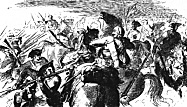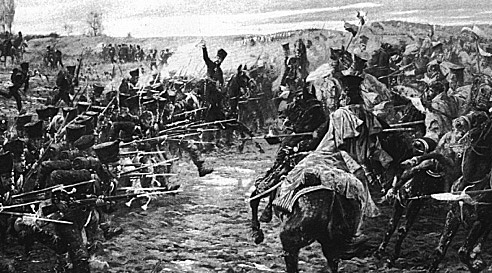There is, in the popular military literature, a misconception about the frequency of bayonet charges executed against cavalry. It is reputed that there were only three such charges in history:
-
1. The Prussian Bernberg Infantry
Regiment attacking Austrian cavalry at
Liegnitz in 1760;
2. The Russian Lithuanian Guard Infantry Regiment attacking French cavalry at Borodino; and
3. The British 5th Foot Regiment attacking French cavalry at El Bodon in 1811.

In fact, there appear to have been more instances. Since I spend more time reading about the Napoleonic Wars than I do other periods, I have encountered few non-Napoleonic instances of this, but during the Seven Years War British infantry appears to have charged French cavalry during the Battle of Minden.
In the non-English Napoleonic literature, however, I have encountered several instances of attacks executed by infantry against cavalry. The first such attack is reported in a letter from General Lorencz to Marshal Oudinot. It occurred on 18 May 1813 in a battle near Neukirchen when the French 52nd and 137th Line Regiments formed square against a Russian cavalry attack, repulsed two such attacks, reformed into column, and advanced more than once at the pas de charge against that cavalry.
In a second instance, during the battles around Katzbach on 26 August 1813 the 4/34th Line Regiment found a force of Prussian Uhlans that had charged into and captured the park of the XI Corps. While only about one sixth of their muskets would fire because of the day long rain, the 4/34th charge in a battalion mass against the cavalry, drove it away, and recaptured the XI Corps park. They do not appear to have suffered any appreciable losses.
While doing some research on the 1814 campaign I encountered a third and most unusual account of another bayonet attack by French infantry against cavalry. It occurred during the battle of La Fere-Champenoise fought on 25 Marchl814 and was executed by an entire brigade! Slightly earlier, on 5 March, Pacthod's Division was shown, in archival documents, to contain the following units. Koch states that it still was a Division formed of National Guardsmen at La Fere-Champenoise, so it is unlikely that it had changed significantly.
National Guard Division
General de Division Pacthod (5 March 1814)
-
1st Brigade: General de brigade Rost
-
1st Regiment of Sarthe (25/990)*
3rd Regiment of Indre et Loire (29 / 662)
-
2nd Regiment of Loire et Cher (44/984)
5th Regiment of Seine et Marne (8/263)
-
4th Regiment Maine et Loire (33/989)
-
26/6th Foot Artillery (2 8-pdrs & 4 4-pdrs)
Det/2nd (bis) Train Battalion
Det/4th Principal Train Battalion
-
24/6th Foot Artillery (4 12-pdrs & 2 howitzers)
12/8th Foot Artillery (4 6-pdrs & 2 howitzers)(8 6-pdrs & 4 howitzers)
Det/12th (bis) Train Battalion Train
8/3rd Horse Artillery (4 6-pdrs & 2 howitzers)
The French were greatly outnumbered and the main armies, under Marmont and Mortier, were fighting a desperate rear action when a French column suddenly appeared on their flank and became entangled in a savage battle with the allies. This was Pacthod's Division. Pacthod had not been marching to the sound of the battle, but had instead been escorting a convoy of supply wagons and blundered into the battle. Perhaps it is better to say that the battle blundered into him faster than he could move away from it with his precious charge.
Realizing he was in trouble, Pacthod attempted to continue his march, retreating en echiquier. The convoy advanced with a frontage of four wagons and all soon reached Clamange. Once there, however, it became necessary to abandon the convoy or risk the certain destruction of his troops. The horses were stripped from the wagons and the teams on the guns were doubled. To cover this operation Major Caille was sent to occupy Clamange with two battalions where he fought off numerous attacks by strong cavalry forces.
The withdrawal continued in regimental squares. At their wings and across their rear stood 16 cannons. The squares and cannon savagely flailed the Allied cavalry with canister and musketry, teaching them that the French were still to be respected.
General Pacthod sought to gain the safety of La Fere-Champenoise in this formation, but Count Pahlen II succeeded in establishing himself behind Pacthod's Division with the Dorpat and Lithuanian Chasseurs a Cheval Regiments. This presented Pacthod with the alternative of surrendering or fighting his way through. After a short council, General Delord proposed charging the Russians with his infantry, while the rest of the French troops contained Korff's forces. This recommendation was adopted. As soon as Delord's brigade was formed in attack columns, it advanced at the pas de charge against Pahlen's Russian cavalry and forced them to withdraw. However, the sounds of battle had attracted the cavalry of Sacken's Corps, which appeared to replace Pahlen and executed several charges. Delord was obliged to form his brigade in squares and withdraw.
Despite their bravery, Pacthod's Division was eventually overwhelmed by the Allies' cavalry and the arrival of the Russian Guard Infantry and Artillery. The Russian artillery deployed and began shredding the helpless French squares. Despite its bravery, Pacthod's Division was decimated.
This battle is particularly interesting because of the size of the attack, a full brigade, potentially 1,500 men. It was desperate but deliberate. Most impressively, it was executed by National Guardsmen who had been called to the colors in the previous four months! Either they were marvelously trained and confident in themselves, incredibly foolish, or knew that it was either do or die situation.
I am quite sure that there were many other such instances, but that the records of such actions are very rare. Perhaps it is a matter of the authors thinking very little of it and not bothering to report these instances. On the other hand, it is more likely that it was not a infrequent occurrence, but generally only a tactic used in the most desperate of situations. Whatever the reason, the popular impression that it was an almost unheard of action is obviously wrong. But there are even more and later instances of such attacks.
The last such attack in history appears to have occurred on 27 April 1920, during the Polish-Soviet War. The Russian 7th Rifle Division executed a bayonet attack against a Polish cavalry brigade near Malin. In contrast to the other such reported incidents, the casualty figures for this clash are not totally unknown. Records show that the Russians lost 40% of their strength! That is more than enough to discourage any but the most desperate from attempting such an act.
Related:
-
More on Bayonet Attacks by Infantry Against Cavalry
Part I: On Napoleonic Squares (by George Nafziger)
Part II: More on Squares (by Jean Lochet)
Bibliography
Davies, N., White Eagle, Red Star; The Polish-Soviet War 1919-1920, London, 1983, Orbis Books Ltd.
Fabry, G., Journal des operations des III et V Corps en 1813 Paris, 1902, Librairie
Militaire R. Chapelot et Cie.
Foucart, P.J., Bautzen (un bataille de deux jours) 20-21 mai 1813 Paris, 1897,
Berger-Levrault & Cie.,
French Archives, Carton C2/556
Koch, F., Memoirs pour servir a l'Histoire de la Campagne de 1814, Paris,
1819, Chez Magimel.

Two companies of Silesian Schutzen
under Captain von Neuman charge the
Guard Lancers with the bayonet at Etoges, 1814.
Back to Empire, Eagles, & Lions Table of Contents #11
Back to EEL List of Issues
Back to MagWeb Master Magazine List
© Copyright 1995 by Emperor's Headquarters
This article appears in MagWeb (Magazine Web) on the Internet World Wide Web.
Other military history articles and gaming articles are available at http://www.magweb.com
